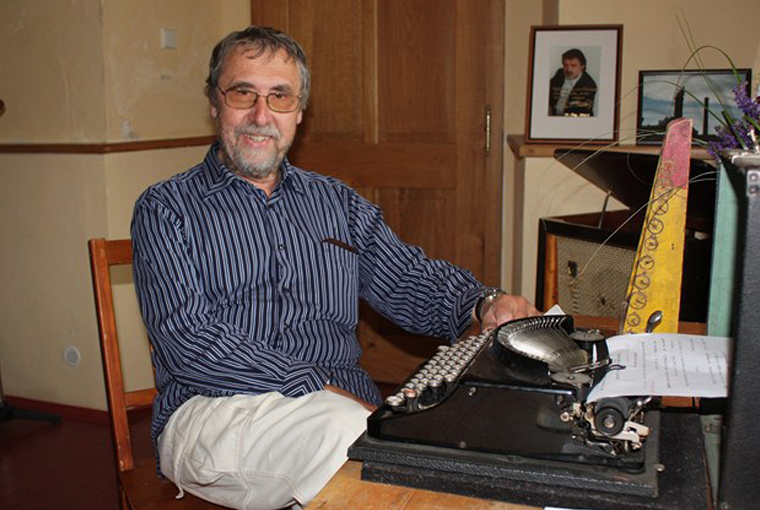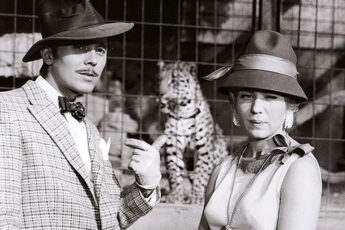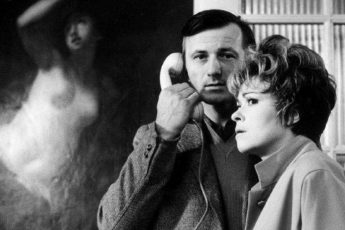
Jaromír Šofr was a leading cinematographer of the Czech New Wave, working on all feature films of Jiří Menzel, including the famous “Closely Watched Trains,” as well as other notable films from different directors, like Věra Chytilová’s “Ceiling” or Karel Kachyňa’s “Long Live the Republic”. A graduate from FAMU, the national film school, Šofr made his way into the professional industry through peers and connections.Šofr speaks about his formation, his involvement in the New Wave, and working with directors of different styles and ages.
How did you end up going to FAMU? Did your family expect you to go to school?
You mean my family background? It’s very simple. My grandfather and my father, they were pharmacists. My grandfather founded a pharmacy in a small South Moravian town so my family background was very suitable for my career because I spent a happy childhood in a good family. But my father and my mother were victims of the Communist regime in our country, so the family was badly affected. The Communists wanted our property. After finishing high school in a small town, I was accepted at FAMU. So I was lucky enough to start studying here. I started to study at FAMU when I was sixteen, seventeen. I was born before the Second World War, in 1939, so I was very young when I started here. I was very lucky, because I collaborated with the directing class below me. It was a rule at FAMU that cinematographers of the upper classes had to work with directors of a lower class. And in this lower class were very gifted and intelligent students. Jiří Menzel and Věra Chytilová were among them. I met Jiří Menzel in a night train for the first time; we were transported to help in agriculture picking potatoes. And then we had a studio exercise together.
You had to go pick potatoes?
Yes. At the time, there was a rule that students had to help cooperative farmers as everything was being nationalized. Later, I also collaborated with Věra Chytilová. First I shot some exercises for Jiří Menzel. In the first year at that school I was not too successful because I was not a very gifted photographer. But when we started to make real movies, I DoPed Jiří Menzel’s things. Ab early one was called Industrial Building Houses. The film was in color and very well-received. My final film I shot with Věra Chytilová. The movie title was “The Ceiling”, a good film which would be significant for my later career.
During our education here at this school, we were very influenced by the French New Wave, and cinematographers such as Raoul Coutard. Henry Decae was especially influential for me. Fortunately, the rector of our school was Mr. Brousil, a very significant personality. This rector was able to organize screenings of new movies shot in France, Italy and other European countries. So you could say we were comparatively well informed. In fact, that’s mainly thanks to the teachers. There were several very influential professors teaching here at the time. We were well-prepared for our careers.
With whom did you study as a teacher for directing and cinematography?
I studied cinematography, not directing. The school was founded in 1946 and consisted of four departments: screenwriting, production, directing and cinematography. So I studied just cinematography. And thanks to Ceiling, our career started very early. So I was invited to collaborate with more established people, like Karel Kachyňa, with whom I had my first professional project.
That was “Long Live the Republic” (1965)?
Yes, Long Live the Republic. It was my first film shot under professional conditions. That was in Barrandov, and shooting took two years. When I served in the military as a solider, I was hired for shooting. The movie was shot in two parts. For the first part I shot as solider, but with many privileges, of course. The second year I was in the position of a citizen. So it was my first project.
So the first year you had to be on an army base part of the time?
Yes, for the first half of the shooting. The first year I spent as a normal soldier. Still, it was not a normal position because I was employed in the army film department, a special institution. So I was fortunately shooting from the very beginning of my time in the army.
The Ceiling was widely appreciated by various institutions. Hence, I was invited to make similar projects in the future. That way, I gained some experience with different genres. Very significant was this film, Long Live the Republic. It was the first time in my life I shot widescreen – Cinemascope. At the time the aspect ratio was 1 to 2.55, very wide. My camera crew and me, we were very pleased, because it was an opportunity to use the format very freely. So it was comparatively original and successful, and the real start of my career. Very soon I was asked to shoot Closely Watched Trains (1966) with Jiří Menzel.
When I think about it, there weren’t too many films in color shot during that era. In 1970, you made “Capricious Summer”. That’s in color, right?
Yes. Capricious summer, Rozmarné leto. It was my second project with Jiří Menzel. But before this I shot A Report on the Party and the Guests with Jan Němec. It was in black and white also. I started shooting it just after finishing Long Live the Republic. With Němec, we were shooting a sort of Czech variant of the cinema vérité style. It was very challenging, because I had become accustomed to the new style.
And the new style was not like cinema vérité?
The new style was, let’s say, similar. There are similarities, but there are also differences. Because France and our Czech mid-European taste are of course slightly different. But the French cinema vérité was very important to me, especially movies like The Lovers, directed by Louis Malle with cinematographer Henri Decae. The look of twilight situations, dark twilight situations, night situations with sufficient light throughout the scene — it’s a very special representation. I know that at the time, styles were divided in France, too. Some concepts were very documentary-like, without any special effects. Films were made in small rooms, and diffused light bounced from the walls. In this respect the movie Les Amants was different. It was more professional and more subtle work when it comes to the atmosphere. It is close to my taste, it was a great film.
About diffused light, I saw, I think it was “The Golden Sixties” (2009), this interview with Němec. He said you invented some kind of tent to diffuse the light…
Yes. [Laughs] I tried to help him with fast and continuous shooting. Sometimes during exterior shooting it’s impossible to proceed quickly and be concentrated just on the performance of the actors, because the conditions are rapidly changing. So I used this time to construct a special diffusing ceiling from plastic material which enabled me to shoot without changes in the light intensity. So it was possible to shoot during sunshine, since it was diffused by the ceiling. I know that such diffusive material on the set is nothing new, because it was used by some pioneers of directing like Georges Méliès, but I think this was the first time it was used in such a big exterior scene.
Yes, I think it gives the film a special look. I don’t know how to describe it, but the light is very soft…
Yes, it was soft. It brought unity, you know, that was the main purpose of the endeavor. The movie was driven by long lens shots, so for some close-ups and semi close-ups I used long focus lenses. And it brings a special look to the perspective of the image. Also the structure of the movie was stylized: every new setting of the film was introduced with a wide shot that would allow viewers to get accustomed to the surroundings. And then we concentrated on the actors’ work in longer lenses. Stylization was also supported by use of black and white stock, so differences between changing weather conditions were not visible. During the shootings we were all amazed by the actors’ achievements. They weren’t really actors. They were predominantly significant intellectuals and artists from different branches of the arts — photographers, music composers, etc. The adopted son-hero of the host, Jan Klusak, was a famous composer. And there was the brother of Jan Němec, and Evald Schorm, a director.
Was it very different working for someone from your generation, like Jan Němec, versus Kachyňa, who was older?
Yes, it was very different. But fortunately Kachyňa was educated as a cinematographer, too. So the main difference in approach was that my generation requested all sync shooting. Such shooting was complicated by the fact that we used big movie cameras. One of the lightest is this Arriflex in a box called Arriblimp. A camera like this was used for shooting Closely Watched Trains. That is a comparatively light camera. But usually it was necessary to use a French model called Debris, which weighs 100 kilos. That was also the camera that we used for The Party and the Guests: Super Polar Debris.
Did you have to shoot quickly for the new directors?
Not with all. The pace of shooting with Jiří Menzel was not so fast; Capricious Summer was particularly slow because the weather conditions were very inconvenient. It was a sunny summer, and we needed a cloudy sky. That slowed shooting down a great lot. But with some directors, like Jan Němec, it was a very quick process. Karel Kachyňa was a professional, a skillful and experienced person. He always planned the shooting using dolly tracking, and he spent the time when the dolly tracks were being set up on a difficult terrain, the forest or something, playing cards with other crew members. I remembered the shooting was a great challenge, and I was very happy to collaborate with him. In fact, I made a great mistake by refusing to collaborate with him after: I was given the chance to continue with Mr. Kachyňa. His next project was Carriage to Vienna.I refused to continue to collaborate with him because I wanted to return to my colleagues, my schoolfellows, and I did return to the world of my peers. Fortunately, very soon I joined some talented directors from my generation – Jaromíl Jireš, and very soon Jiří Menzel. So I continued. I shot films with directors of different ages, including very old directors, for instance Otákar Vávra and Jiří Krejčík, significant directors. Sometimes, I would join Věra Chytilová. In 1978, we made Panel Story together. But mainly Jiří Menzel – I shot nearly all of his films. It was only at the beginning that Menzel was forced to hire an older cinematographer and his first one or two films were DoPed by some other cinematographer.
Was it very different working in the 1970s versus the 1960s? Because, as I understand, the head of Barrandov was fired and replaced in the late ‘60s.
Yes, the situation was influenced badly by politics, especially after the Russian invasion in ‘68. That didn‘t happen immediately… there was a kind of inertia. Some people involved in the previous progressive trends remained in important positions. The change was gradual. But it was more or less carried through to the end in the 1970s. In 1970s, a KGB guy was appointed head of dramaturgy at Barrandov, and that‘s when things really changed for the worse.
Toman?
Toman, yes. Censorship made it difficult to shoot high-quality films from then on. But we survived. In the early phase of this difficult period, in 1969, I shot Larks on a String with Menzel, which was banned immediately. There were some attempts to make the film accessible to public screenings by making some changes and censoring some scenes. This initiative was made by the director of Barrandov studios, Vlastimil Harnach, who removed the scenes. Since we couldn’t retrieve them even after 1989, I was forced to copy them from intermediate negatives, the only prints which contained these shots. Obviously, the quality was badly affected. But the significance of this movie is impressive nevertheless. I think that the technical obstructions didn’t fully destroy the film. Soon, new prints of the movie were made and it was presented at a film festival in Berlin.
I think we survived this period without any significant harm because Czechoslovakia was never part of the Soviet Union. In the Soviet Union such sabotage would have catapulted you to prison. We managed to do without that.
But you still saw quite a few of your films from that period banned, right? Like the one you shot with Evald Schorm…
Oh yes, End of a Priest (1969).
And that was banned, wasn’t it? It was one of those films “banned forever”.
End of a Priest was fortunately screened several times. It was shot in 1968. Just imagine, we finished the movie just one day before the Soviets invaded our country. So we entered Prague from the exterior. The film had been completed, so it was screened several times, only that public screenings were prohibited. So it was my last movie I did with Schorm. The ‘70s were hard times. Now it’s different, but it’s still diffult: we have the so-called capitalist order, which is also difficult for us filmmakers because there is insufficient money, and prints and film quality are sometimes very low.
What about the privatization of Barrandov?
That was a very shameful process. Privatization was not always done by principled people. It was not a clean procedure. In the end, the studio ended up in the hands of people who hadn’t been involved in the film industry previously. Now it is in the hands of enterprises of quite different branches. It is used for foreign producers and foreign projects. It’s not available to Czech film production because no Czech film has a sufficiently high budget. So no Czech project can afford to shoot in the Barrandov studios. There are very unpleasant consequences of the wild privatization in our country. It’s hard to influence it.
Since you work with students today, do you think that sometime that’ll change? That there’ll be a rebirth of Czech film?
I am partially pessimistic, and partially optimistic. Students need to understand that there is a future in different genres, not just in fiction movies. But there are some ex-students who’ve made some fiction films in the past few months. I can name a group of around ten recent graduates of our school who’ve made significant projects when it comes to the cinematography. Fresh graduates, but very good cinematographers. I think education here is intense and qualitative. Our teaching staff consists of many professionals. In 2006, I was able to give up the position of department head, which allowed me to return to my profession. In 2006, I shot I Served the King of England, again with Menzel.
Great film.
So I escaped from the position of head of department and after 15 years of fulfilling that duty, I was relieved. In the ‘90s, I still shot a lot. I shot The Beggar’s Opera (1991), written by our president Václav Havel, and directed by Menzel. And I shot another project also. The not-too successful Extraordinary Adventures of Private Ivan Chonkin, from 1993. It was based on novel by a Russian novelist, Vladimir Voinovich.
Last summer, I shot Skirt Chasers with Menzel, his last project. We were not able to find a better title. The story revolves around a group of singers preparing for a performance of Mozart’s Don Giovanni in a small Czech town. Maybe we’ll replace the tile, maybe we won’t find a better one. But the movie is not as lascivious as the title may suggest. It’s something completely different. Shooting time was 55 days, so I presume that editing will last a while. Since we shot with a digital camera, Alexa, the overall number of shots ended up being enormous. Digital shooting is different from analog: it enables repeating shots to fully satisfy the director.
More work for you!
Yes, very tiring. I was very exhausted. Shooting twelve hours a day is too much for me.
Thank you for the interview.




Leave a Comment